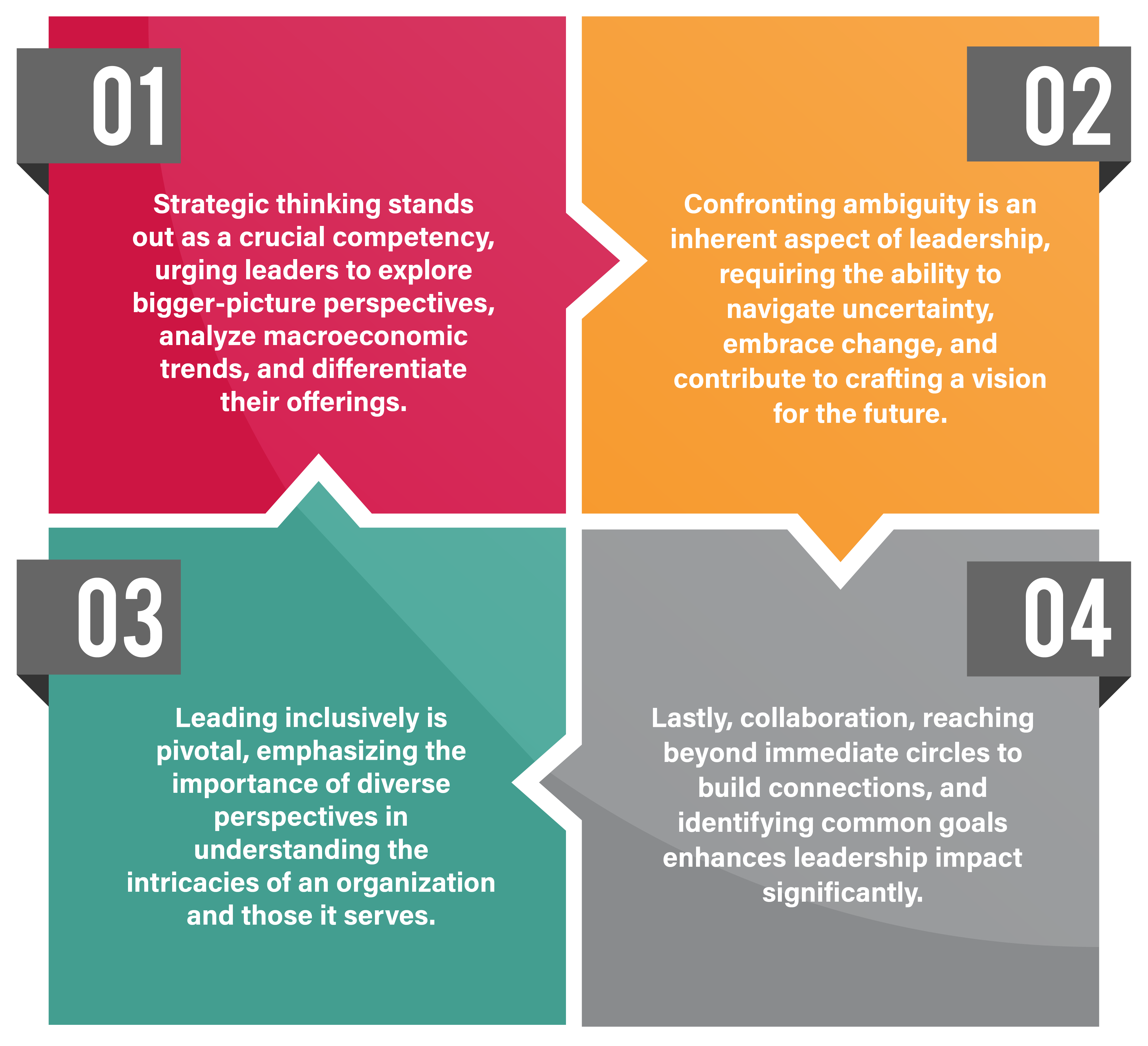
Embarking on a journey of leadership development involves more than just honing technical skills; it requires a focus on key competencies that elevate your impact.
- Strategic thinking
- Confronting ambiguity
- Leading inclusively
- Collaboration

Growth in these four areas is critical if leaders want to elevate their contributions to the organization, says CPED Program Director Lisa Yaffe. Consider how these competencies can expand your leadership influence and contribute to your organization’s broader success.
Leadership Competency #1: Strategic Thinking
Strategic thinking is the ability to envision the bigger picture, enabling proactive decision-making and ensuring alignment with long-term objectives. “Strategic thinking is thinking beyond the current thinking. It’s thinking at a higher level – and directionally. Think about competitively differentiating your offering or fulfilling your organization’s mission or services goals,” Yaffe says.
Leadership requires a strategic outlook. By thinking beyond current situations, you can anticipate challenges, identify opportunities, and steer your team and organization toward sustained success.
How can you develop your strategic thinking?
- Continuous learning: Stay informed about industry trends, emerging technologies, and global shifts. You’ll also find professional development programs that focus on developing and enhancing strategic thinking skills.
- Scenario planning: Spend some time anticipating future scenarios and developing strategies to navigate potential challenges. Even if these challenges never arise, the act of practicing this thinking and planning will help your strategic thinking skills.
- Collaborate: Engage in discussions with diverse perspectives to gain a comprehensive understanding of different viewpoints.
- Mentorship: Seek guidance from experienced leaders who have honed their strategic thinking skills over time.
Additional resource: Five Ways to Encourage Strategic Thinking
Leadership Competency #2: Confronting Ambiguity
Leaders are on the cusp of the current and what’s being created for the future. With that comes a lot of ambiguity, Yaffe points out. “There’s lack of direction from above. How do we make the vision or direction from leaders come to fruition?”
Leaders need to recognize it’s part of your job to carve a path forward in spite of ambiguity, Yaffe adds.
Dealing with ambiguity involves thriving in uncertain environments where clear direction may be lacking. This requires you as to navigate the transition between the present and the future.
“As a leader, you often encounter situations where the next step is unclear. You need to be comfortable with not having all the answers yet and understand how you can contribute to a conversation about that,” Yaffe adds.
When you become comfortable at handling ambiguity, you can demonstrate confidence, make a more informed decision, and guide your team through transitional phases while fostering adaptability and resilience.
How can you begin to embrace ambiguity?
- Develop a comfort level with uncertainty. Acknowledge that ambiguity is inherent in leadership. Recognize that leading involves moving forward without perfect information.
- Be flexible with decision-making. Develop a dynamic decision-making process that accommodates changing circumstances.
- Create open communication. Encourage open dialogue about uncertainties. Foster a culture that acknowledges and addresses ambiguity. Don’t always turn ambiguity into a negative.
- Learn from the past. Reflect on your past experiences of uncertainty, identify lessons learned, and refine that knowledge for future approaches.
Leadership Competency #3: Leading Inclusively
“There is no one individual role or one individual function that can see everything about an organization and the people it serves.” Lisa Yaffe, CPED Program Director.
Leading inclusively involves creating an environment where diverse perspectives are valued and integrated into your decision-making process. Inclusive leaders want to understand the viewpoints of everyone the organization serves, from employees to customers.
Inclusive leadership has the power to enhance organizational innovation, employee engagement, and customer satisfaction. It shouldn’t be seen as a burden but an opportunity. By recognizing and appreciating all perspectives, leaders can make well-informed decisions that consider the needs of all stakeholders.
How can you become a more inclusive leader?
- Be an active listener.
- Value input from all team members and stakeholders. Actively seek input from individuals with different viewpoints..
- Encourage diverse thought, and acceptance of diverse thought, within your team.
- Equip yourself with the knowledge to understand and appreciate various perspectives and cultures.
Leadership Competency #4: Collaboration
Collaboration creates connections, encourages partnerships, and identifies shared goals. It’s about expanding your network and building alliances.
Effective leaders understand the power of partnerships. Collaborations across boundaries enables your team and organization to tap into diverse expertise, share resources, and collectively address challenges, leading to enhanced innovation and impact.
“Reach across boundaries, create new connections, find new common goals. All of that is a really rich place for increasing your impact and elevating your leadership.” Lisa Yaffe, CPED Program Director.
Also consider how broadly you are impacting your organization. Do you merely think in terms of your function? Do you think more broadly in terms of interacting with other functions or higher levels?
Yaffe encourages you to ask yourself questions like:
- How are functions working together to support each other?
- How do you collectively own the talent and the capacity and the capability beyond just your areas of expertise? How can you start influencing more broadly?
- Where can you create partnerships with others to understand your organization and its systems in a broader way?
- How can you expand your scope?
How can you increase your collaboration?
- Seek opportunities. Identify shared objectives with other individuals, departments, teams, or even organizations.
- Communicate. Clearly communicate the benefits of collaboration and how it aligns with mutual interests.
- Build trust. Demonstrate your reliability, transparency, and commitment to help cultivate trust with others in and outside your organization.
- Network. Actively participate in organization and industry events, conferences, forums, etc. Expand your professional network both within and outside your organization.
Prioritize Your Growth
As you contemplate the significance of these competencies, consider how they can expand your leadership influence and contribute to your organization’s broader success. Now is the perfect time to boost your career through continuous learning.
Whether you want to improve your big-picture thinking, handle uncertainty like a pro, include everyone on your team, become a collaboration expert, or develop other leadership competencies, the rewards are huge.
Leadership development helps you handle changes, come up with new ideas, and stand out at work. Stay ahead, get smarter, and make a lasting difference in your career, with your team, and at your organization.
Take your career to new heights by making leadership development a regular part of your journey.
View Leadership Development Programs
This article was written with assistance from AI.